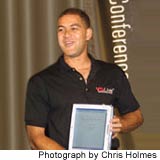|
||||||

|
||||||
|
New Microsoft Mobile Tools Arrive
VSLive! Orlando, September 17, 2002
In a packed keynote session, Momoh told developers they have the chance to drive the mobility phenomenon. Along with Microsoft product managers, Momoh demonstrated new Visual Studio .NET mobility features, expected in the next release of Visual Studio .NET next year. The .NET Compact Framework represents a subset of the Visual Studio .NET class libraries on top of a full-featured IL executable. (For more information about the Visual Studio Compact Framework, see http://msdn.microsoft.com/vstudio/device/compact.asp. Visual Studio .NET's new mobility features make it easier for developers to target multiple devices with a single code base. Momoh described this "common toolset" as reaching across devices - overcoming many enterprises' frustration with having to use multiple tools to target multiple devices. All the Visual Studio languages support mobile development, including Visual J#, Momoh announced today. (More information about the mobile device capabilities in Visual Studio.NET, see http://msdn.microsoft.com/vstudio/device/sde.asp.) One highlight of the presentation was his demonstration of ASP.NET Mobile Controls. Using these controls, an application can automatically adapt to a wide range of device-specific browsers "with no additional work on your part," said Momoh. Ed Kaim, Mobile Product Manager at Microsoft, demonstrated database reporting across multiple clients, using a sample third-party reporting tool, Crystal Reports 9. Crystal Reports' latest release includes a .NET Compact Framework reporting control. Kaim demonstrated sending notification of a report,with a URL, to his mobile phone as an SMTP message using a straightforward expression: System.Web.Mail.SmtpMail.Send(). Kaim also promised a datagrid in the final release of the .NET Compact Framework. Managers from Xerox also showed off mobile asset management software that they built using the .NET Compact Framework. With the software, field representatives can make changes to printers using a Pocket PC on site. Xerox is planning to deploy the technology to several thousands accounts. According to Xerox Software Development Manager Kirk Pothos, Xerox used the .NET Compact Framework because it allowed easy integration using XML Web services. "The .NET Compact Framework is real, and the results we achieved with it are real," he said. Microsoft senior program manager Kevin Collins demonstrated a sales force automation application used by GlaxoSmithKline that allows independent representatives to measure inventory at retail stores, checking, for example, which of the company's products are on the retailer's shelves and in the proper shelf position. The worker plugs in a modem to a Windows CE device and synchronizes the SQL Server CE database on the device with a central database. At the store, the representative scans products with a plug-in scanner, and data from their bar codes is compared with data in the device. Later, the results are uploaded to GlaxoSmithKline. Collins said the SQL Server CE application cuts representatives' time in stores in half and allows GlaxoSmithKline to get the data overnight, compared to three weeks later with the previous paper-based system. SQL Server CE 2.0 provides several improvements over the previous release, including query enhancements, an improved Query Optimizer, and improved, Wizard-based security configuration. Microsoft demonstrated a real estate application that synchronized local Multiple Listing Service (MLS) data with a mobile device. Demonstration code used .Synchronize() to show how straightforward data synchronization between device and server is. (For more information on SQL Server CE 2.0, see http://www.microsoft.com/sql/CE/default.asp.) About the Author |

